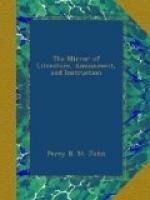“The priory and hospital of St. Mary Spittle, was founded (says Pennant) in 1197, by Walter Brune, Sheriff of London, and his wife, Rosia, for canons regular of the order of St. Augustine. It was remarkable for its pulpit cross, at which a preacher used to preach a sermon consolidated out of four others, which had been preached at St. Paul’s Cross, on Good Friday, and the Monday, Tuesday, and Wednesday in Easter week; giving afterwards a sermon of his own. At these sermons the mayor and aldermen attended, dressed in different coloured robes on each occasion. This custom continued till the destruction of church government in the civil wars. They have since been transferred to St. Bride’s Church. Queen Elizabeth, in April, 1559, visited St. Mary Spittal, in great state, probably to hear a sermon delivered from the cross. This princess was attended by a thousand men in harness with shirts of mail and corslets, and morice pikes, and ten great pieces carried through London unto the court, with drums and trumpets sounding, and two morice-dancers, and in a cart two white bears.”
The priory of St. Mary, of St. Mary Spittle, contained at its dissolution, about the year 1536, no less than 180 beds for the reception of sick persons and travellers. Richard Tarleton, the famous comedian, at the Curtain Theatre, it is said, “kept an ordinary in Spittle-fields, pleasant fields for the citizens to walk in;” and the row called Paternoster Row, as the name implies, was formerly a few houses, where they sold rosaries, relics, &c. The once celebrated herbalist and astrologer, Nicholas Culpepper, was another inhabitant of this spot. He died in 1654, in a house he had some time occupied, very pleasantly situated in the fields; but now a public house at the corner of Red Lion Court, Red Lion Street, east of Spittlefields market. The house, though it has undergone several repairs, still exhibits the appearance of one of those that formed a part of old London. The weaving art, which has arrived at such an astonishing perfection, was patronized by the wise and liberal Edward III., who encouraged the art by the most advantageous offers of reward and encouragement to weavers who would come and settle in England. In 1331, two weavers came from Brabant and settled at York. The superior skill and dexterity of these men, who communicated their knowledge to others, soon manifested itself in the improvement and spread of the art of weaving in this island. Many Flemish weavers were driven from their native country by the cruel persecutions of the Duke d’Alva, in 1567. They settled in different parts of England, and introduced and promoted the manufacture of baizes, serges, crapes, &c. The arts of spinning, throwing, and weaving silk, were brought into England about the middle of the fifteenth century, and were practised by a company of women in London, called silk women. About 1480, men began to engage in the silk manufacture, and in the year 1686, nearly 50,000 manufacturers, of various descriptions, took refuge in England, in consequence of the revocation of the Edict of Nantz, by Louis le Grand, who sent thousands (says Pennant) of the most industrious of his subjects into this kingdom to present his bitterest enemies with the arts and manufactures of his kingdom; hence the origin of the silk trade in Spittlefields.




